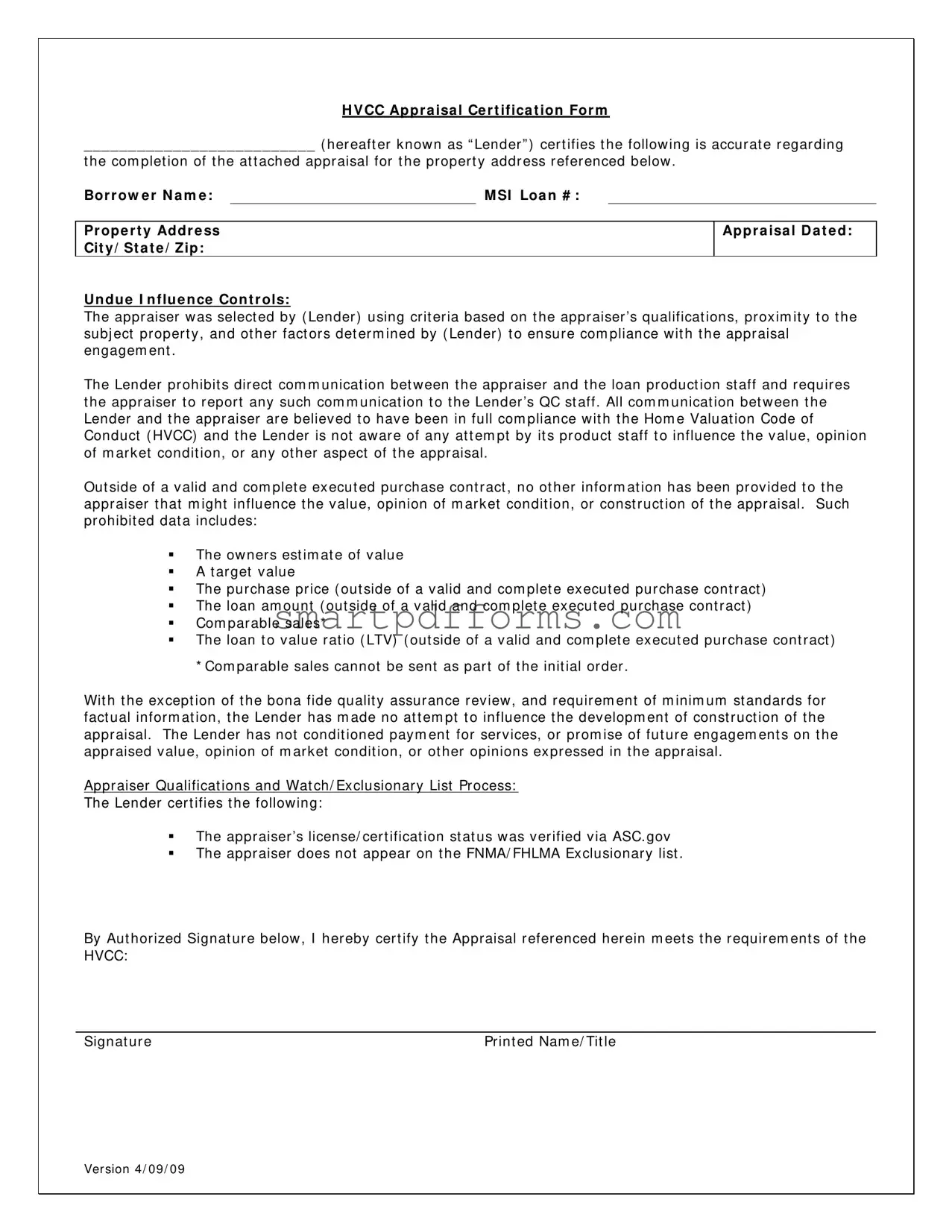H V CC Ap p r a isa l Ce r t if ica t ion For m
__________________________ ( her eaft er k now n as “ Lender ” ) cer t ifies t he follow ing is accur at e r egar ding
t he com plet ion of t he at t ached appr aisal for t he pr oper t y addr ess r efer enced below .
Bor r ow e r N a m e : |
|
M SI Loa n # : |
Pr op e r t y Ad d r e ss Cit y / St a t e / Z ip :
Ap p r a isa l D a t e d :
U n d u e I n f lu e n ce Con t r ols:
The appr aiser w as select ed by ( Lender ) using crit er ia based on t he appr aiser ’s qualificat ions, pr ox im it y t o t he subj ect pr oper t y , and ot her fact or s det er m ined by ( Lender ) t o ensur e com pliance w it h t he appr aisal engagem ent .
The Lender pr ohibit s dir ect com m unicat ion bet w een t he appr aiser and t he loan pr oduct ion st aff and r equir es t he appr aiser t o r epor t any such com m unicat ion t o t he Lender ’s QC st aff . All com m unicat ion bet w een t he Lender and t he appr aiser ar e believ ed t o hav e been in full com pliance w it h t he Hom e Valuat ion Code of Conduct ( HVCC) and t he Lender is not aw ar e of any at t em pt by it s pr oduct st aff t o influence t he v alue, opinion of m ar k et condit ion, or any ot her aspect of t he appr aisal.
Out side of a v alid and com plet e ex ecut ed pur chase cont r act , no ot her infor m at ion has been pr ov ided t o t he appr aiser t hat m ight influence t he v alue, opinion of m ar k et condit ion, or const r uct ion of t he appr aisal. Such pr ohibit ed dat a includes:
The ow ner s est im at e of v alue
A t ar get v alue
|
The pur chase pr ice ( out side of a v alid and com plet e ex ecut ed pur chase cont r act ) |
|
The loan am ount ( out side of a v alid and com plet e ex ecut ed pur chase cont r act ) |
Com par able sales*
The loan t o v alue r at io ( LTV) ( out side of a v alid and com plet e ex ecut ed pur chase cont r act )
* Com par able sales cannot be sent as par t of t he init ial or der .
Wit h t he ex cept ion of t he bona fide qualit y assur ance r ev iew , and r equir em ent of m inim um st andar ds for fact ual infor m at ion, t he Lender has m ade no at t em pt t o influence t he dev elopm ent of const r uct ion of t he appr aisal. The Lender has not condit ioned pay m ent for ser v ices, or pr om ise of fut ur e engagem ent s on t he appr aised v alue, opinion of m ar k et condit ion, or ot her opinions ex pr essed in t he appr aisal.
Appr aiser Qualificat ions and Wat ch/ Ex clusionar y List Pr ocess:
The Lender cer t ifies t he follow ing:
The appr aiser ’s license/ cer t ificat ion st at us w as v er ified v ia ASC. gov
The appr aiser does not appear on t he FNMA/ FHLMA Ex clusionar y list .
By Aut hor ized Signat ur e below , I her eby cer t ify t he Appraisal r efer enced her ein m eet s t he r equir em ent s of t he HVCC:
Signat ur e |
Pr int ed Nam e/ Tit le |
Ver sion 4/ 09/ 0 9

